Studies have shown that early enrichment creates well adjusted, clever and calm chickens that easily find their way in the environment and are less fearful to new things. All good reasons to create a stimulating, interesting and creative brooder for chicks.

In this article I'll recite research and studies done on early enrichment, chick development and chickens' cognitive abilities. Most of the studies are done on chicks that will grow up to be layer hens, with the focus of improving their general well being and minimize bad habits such as feather pecking. I'll then make a list on enrichment suggestions, and test some on my own chicks. List over reviews and studies are found at the bottom.
What is enrichment?
Ruth C. Newberry, PhD wrote: "Enrichment should have impact by increasing the performance of natural behavior, reducing the incidences of abnormal and damaging behavior, reducing negative emotional states, improving physical health, and improving the use of the provided environmental resources."
In other words, enrichment is anything that give chickens the opportunity to do what their instincts tells them, be happy, confident, calm and healthy. We usually talk about physical additions such as treats, playgrounds, roosts, dust baths and litter to kick in, though it can also mean mental stimulation. Anything that will let the bird use all their senses and intelligence.

Modern chickens like the forest floor, just like their ancestors
Jungle fowl live in a complex 3D environment. They must maneuver through obstacles on the forest floor, fly to branches and remember where food sources are, weeks after they found it. They're bombarded with new surroundings and items to react to every day. Our chickens have the same ability to navigate and remember, and if they grow up with challenges, they become really good at it. Key here is "grow up with". Just like we need to practice using a map and compass, so do chickens. Only their maps and compasses are in their heads. It's best to start early and small and don't get thrown into a maze as an adult, and the same goes with reacting to new items.
Neophobia means "fear of new things" and can turn into a big problem with adult animals. Chickens belong to the prey category and will most likely choose the "flight" option in what they perceive as a fight-or-flight situation. Having 20 panicked chickens fly head over heels every time someone walks into their coop is an unpleasant situation for both parties. The other reaction to fear a chicken might show is tonic immobility when it will freeze, standing completely still for a period of time. The only way to battle neophobia is positive exposure to new items, starting early. Riding a roller coaster for the first time is scary, but ride the same coaster the 10'th time and the thrill is less, 'cause you know what's about to happen.
The cognitive chicken
All backyard chicken owners will agree that chickens are intelligent, and so do those who study their cognitive abilities. Chickens have logical reasoning, self awareness, self control, episodic memory, time perception and can count. They also show a wide range of emotions including empathy towards chicks and other flock members.
With that in mind, it's not hard to understand how chickens are also prone to boredom. Feather pecking, egg eating, apathy and pacing are some of the stereotypical behaviors found in poultry. Stereotypical behaviors are a form of stress relief found in captive animals (as in not living in the wild), and consist of repetitive activities that have a negative impact on their health. Not allowing animals to do their natural instincts, overcrowding, not being able to retire to a quiet corner, and a lack of things to do will lead to frustration. In terms on chickens, the way to battle this is to give them enough space, provide such things as roosts and dust bath and give them new and exciting tasks to utilize their intelligence.
The important first weeks
A chick is born fully functional and ready for action. In nature, a chick who's not ready for the world, is one who can't keep up and will die. All the cognitive abilities mentioned above exist in the little chick and it's ready to suck up information, get experience and learn everything there is to know.

A lot of things happen in three weeks
The first weeks are the most important ones in their mental life. This is when the brain is open to be filled. Everything learned, both positive and negative experiences, will stick. After 3 weeks, the brain becomes more stable and will grow on the foundations already built. If chickens are to reach their full mental capacity, they must learn as early as possible. The first week the chick focuses on learning its immediate surroundings and to recognize the ones its with. In this period it also learns what's food and what's not. At 2-3 weeks its focus shifts to responding to the environment, distinguishing friend from foe and remembering where it is and where it's been. Already after 10 days the chick will take little detours from its mom to explore.
The mother hen
A mother hen serves many functions to her chicks. Not only does she provide warmth, she's also their teacher and protector. One of the things she teaches her chicks is how to respond appropriately. Studies that have been conducted on maternal transmission of fear have found that chicks mimic not only how mom responds to danger, but also how strongly. If mom panics when a hawk flies over, the chicks will learn to panic. On the other hand, a mother who acts calm will raise calm chicks.
Finding the right thing to eat is also mom's responsibility. The first week especially, she will guide the chicks to food items by clucking and pecking. If the chicks peck at the wrong things, she intensifies her efforts to redirect them to the food. Some have found a correlation between incubation raised chicks and feather pecking later in life, where the conclusion was that the chicks didn't learn the difference between food and non-food on their own. Food for thought.

Mom and chicks communicate by sound. The maternal clucking is engraved in the chicks from birth, and give them a pleasant feeling when they hear it. It increases their ability to learn and bring happiness. Incubated chicks also react to this kind of sound and will run towards the source, especially if it's accompanied by a moving object such as a hand.
Having a mother to follow will increase the chicks' physical activity. She's a moving heat pad, so the chicks don't need to stay close to a stationary the heat source. Mom will guide them through areas the chicks themselves would be hesitant to walk in and show them what behaviors to perform, such as dust bathing.
All in all, there are quite a few things we, as the incubated chicks' handlers, just can't help them with. However, as their substitute teacher it's our job to try and shape the young ones to be the best version of themselves.
The sensible brooder
I'm an uncreative furnisher, which is the reason I did a deep dive into the area of early enrichment to begin with. Food, water, maybe a thing for them to sit on in the cardboard box with no windows. Yawn! How boring is that for the chick?
Now I'm going to furnish a brooder to entice every one of the chicks' senses, based on what the studies conducted have found. (Literally speaking I'm just putting things on a random floor.) I'm deliberately avoiding bedding, food and water and concentrating only on enrichment.
Visual - eyes
Sight is the number one sense for chickens. This is how they recognize both where they are, and who they're with. New objects peak their curiosity and reduces fear. They have excellent color vision, so using brightly colored objects are good. Balls have the benefit of moving, since chicks focus on movement. Another thing to consider when making a brooder is light, either too much like with a red heat lamp that's always on, or too little like in a brooder with high dark walls. The right amount of light is important so that the eyes develop properly.
Auditory - ears
Sound can be both positive and negative for chicks as high noise, especially mechanical, causes stress. As mentioned earlier, chicks react with happiness to maternal clucking, so talking and "clucking" to them can have the same effect. It's been showed that classical music played to chicks reduces stress. It has to be the right kind of music though, they like rhythmic and harmonic sounds. Talking also serves the purpose of letting them know you're there. They can differentiate human voices, so hearing your voice when you enter the room, ensures them that nothing dangerous is going to happen.
Olfactory and gestation – nose and tongue
In nature chickens eat many different things, so they have a good sense of both smell and taste. Giving chicks tiny treats will help them develop their senses. It's a good idea to peck towards the food items to imitate mom's efforts to teach her offspring the difference between food and not food. Treats should be given in moderation and they must have access to grit. The first weeks, a bit of boiled egg, some oatmeal or a few tiny pieces of apple are enough to stimulate their taste buds.

Tactile – skin, beak and feet
Chicks like to cuddle, they feel safe when they're bunched together in a warm corner with lots of other chicks. A mother hen cave with a heating pad or a heating plate simulates their natural heat source better than a lamp in an open space. The beak is particularly sensitive to touch, so pecking on something is a good way to stimulate their tactile sense, like a hanging string. Their feet should also get used to walking on different surfaces, such as soft bedding, wood, stone and grass.
Movement – muscles and balance
Chicks need to use their bodies in a 3 dimensional environment to build muscles and learn to balance. Roosts, ladders, boxes and other things to climb and stand on and they'll be able to utilize their entire body. Chicks with a brooder that's not just four walls will find it easier to navigate later in life. Boxes and walls also create a "safe space" to go behind for the chicks that are less social than others. Like us people, not all chicks are social butterflies, and some prefer a bit of alone time. Personality develops early, and it's good to let them express themselves as they want.

In practice
I introduced a number of various elements into the brooders of both chicks and ducklings. The initial reaction was caution. After the objects had been deemed safe, the chicks lost interest in them. When I rolled the ball the day after, they hardly reacted to it. Introducing random objects to ease fear works, but they need to be replaced often to keep stimulating their senses.

Greens and other edibles (no, not that kind) is a hit with both young and old. Remember they're meant as enrichment and not nutrition. Young birds should get limited treats, some prefer to not give them any the first month(s). If you do, do it for the entertainment value and give them something that will keep them occupied for a long time without spoiling their appetite.

The bigger the chicks, the more they like to roost and climb, but they prefer to stay half a meter off the ground max. The smallest ones prefer using the heating plate as a resting place. The necessity of a physically complex environment is repeated in many of the studies as a way to reach the chicken's full cognitive potential. This comes with practice. For each wall, hinder, roost and ladder the chick tackles, it has to use its brain and learn. In my opinion this is where most brooders can improve, by adding items not only on the ground, but in height to literally create another level of difficulty.

I got tons of spruce trees around and use brances to create hiding places. They love the privacy.

All in all, furnishing brooders and adding enrichment makes for happy and smart chicks. And it's fun for the owner too, go out and build a playhouse (preferably a better one than mine) and find some old balls and toys (clean them first...). Let the creativity flow into the brooder!
Resources
A review of environmental enrichment for laying hens during rearing in relation to their behavioral and physiological development
Influences of Maternal Care on Chicken Welfare
Sophisticated Fowl: The Complex Behaviour and Cognitive Skills of Chickens and Red Junglefowl
Selection method and early-life history affect behavioural development, feather pecking and cannibalism in layer hens (abstract only)
Early experience affects adult personality in the red junglefowl: A role for cognitive stimulation? (Abstract only)
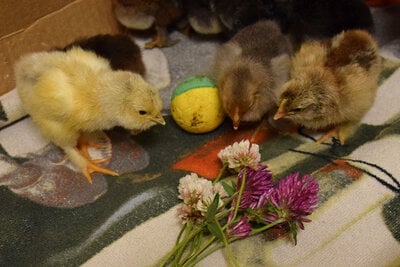
In this article I'll recite research and studies done on early enrichment, chick development and chickens' cognitive abilities. Most of the studies are done on chicks that will grow up to be layer hens, with the focus of improving their general well being and minimize bad habits such as feather pecking. I'll then make a list on enrichment suggestions, and test some on my own chicks. List over reviews and studies are found at the bottom.
What is enrichment?
Ruth C. Newberry, PhD wrote: "Enrichment should have impact by increasing the performance of natural behavior, reducing the incidences of abnormal and damaging behavior, reducing negative emotional states, improving physical health, and improving the use of the provided environmental resources."
In other words, enrichment is anything that give chickens the opportunity to do what their instincts tells them, be happy, confident, calm and healthy. We usually talk about physical additions such as treats, playgrounds, roosts, dust baths and litter to kick in, though it can also mean mental stimulation. Anything that will let the bird use all their senses and intelligence.
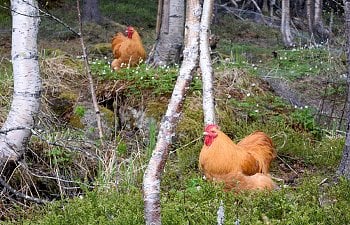
Modern chickens like the forest floor, just like their ancestors
Jungle fowl live in a complex 3D environment. They must maneuver through obstacles on the forest floor, fly to branches and remember where food sources are, weeks after they found it. They're bombarded with new surroundings and items to react to every day. Our chickens have the same ability to navigate and remember, and if they grow up with challenges, they become really good at it. Key here is "grow up with". Just like we need to practice using a map and compass, so do chickens. Only their maps and compasses are in their heads. It's best to start early and small and don't get thrown into a maze as an adult, and the same goes with reacting to new items.
Neophobia means "fear of new things" and can turn into a big problem with adult animals. Chickens belong to the prey category and will most likely choose the "flight" option in what they perceive as a fight-or-flight situation. Having 20 panicked chickens fly head over heels every time someone walks into their coop is an unpleasant situation for both parties. The other reaction to fear a chicken might show is tonic immobility when it will freeze, standing completely still for a period of time. The only way to battle neophobia is positive exposure to new items, starting early. Riding a roller coaster for the first time is scary, but ride the same coaster the 10'th time and the thrill is less, 'cause you know what's about to happen.
The cognitive chicken
All backyard chicken owners will agree that chickens are intelligent, and so do those who study their cognitive abilities. Chickens have logical reasoning, self awareness, self control, episodic memory, time perception and can count. They also show a wide range of emotions including empathy towards chicks and other flock members.
With that in mind, it's not hard to understand how chickens are also prone to boredom. Feather pecking, egg eating, apathy and pacing are some of the stereotypical behaviors found in poultry. Stereotypical behaviors are a form of stress relief found in captive animals (as in not living in the wild), and consist of repetitive activities that have a negative impact on their health. Not allowing animals to do their natural instincts, overcrowding, not being able to retire to a quiet corner, and a lack of things to do will lead to frustration. In terms on chickens, the way to battle this is to give them enough space, provide such things as roosts and dust bath and give them new and exciting tasks to utilize their intelligence.
The important first weeks
A chick is born fully functional and ready for action. In nature, a chick who's not ready for the world, is one who can't keep up and will die. All the cognitive abilities mentioned above exist in the little chick and it's ready to suck up information, get experience and learn everything there is to know.
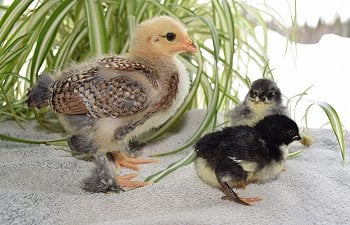
A lot of things happen in three weeks
The first weeks are the most important ones in their mental life. This is when the brain is open to be filled. Everything learned, both positive and negative experiences, will stick. After 3 weeks, the brain becomes more stable and will grow on the foundations already built. If chickens are to reach their full mental capacity, they must learn as early as possible. The first week the chick focuses on learning its immediate surroundings and to recognize the ones its with. In this period it also learns what's food and what's not. At 2-3 weeks its focus shifts to responding to the environment, distinguishing friend from foe and remembering where it is and where it's been. Already after 10 days the chick will take little detours from its mom to explore.
The mother hen
A mother hen serves many functions to her chicks. Not only does she provide warmth, she's also their teacher and protector. One of the things she teaches her chicks is how to respond appropriately. Studies that have been conducted on maternal transmission of fear have found that chicks mimic not only how mom responds to danger, but also how strongly. If mom panics when a hawk flies over, the chicks will learn to panic. On the other hand, a mother who acts calm will raise calm chicks.
Finding the right thing to eat is also mom's responsibility. The first week especially, she will guide the chicks to food items by clucking and pecking. If the chicks peck at the wrong things, she intensifies her efforts to redirect them to the food. Some have found a correlation between incubation raised chicks and feather pecking later in life, where the conclusion was that the chicks didn't learn the difference between food and non-food on their own. Food for thought.
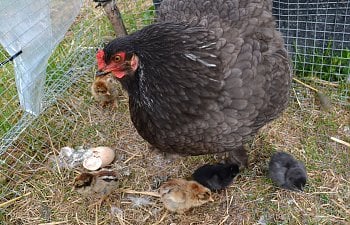
Mom and chicks communicate by sound. The maternal clucking is engraved in the chicks from birth, and give them a pleasant feeling when they hear it. It increases their ability to learn and bring happiness. Incubated chicks also react to this kind of sound and will run towards the source, especially if it's accompanied by a moving object such as a hand.
Having a mother to follow will increase the chicks' physical activity. She's a moving heat pad, so the chicks don't need to stay close to a stationary the heat source. Mom will guide them through areas the chicks themselves would be hesitant to walk in and show them what behaviors to perform, such as dust bathing.
All in all, there are quite a few things we, as the incubated chicks' handlers, just can't help them with. However, as their substitute teacher it's our job to try and shape the young ones to be the best version of themselves.
The sensible brooder
I'm an uncreative furnisher, which is the reason I did a deep dive into the area of early enrichment to begin with. Food, water, maybe a thing for them to sit on in the cardboard box with no windows. Yawn! How boring is that for the chick?
Now I'm going to furnish a brooder to entice every one of the chicks' senses, based on what the studies conducted have found. (Literally speaking I'm just putting things on a random floor.) I'm deliberately avoiding bedding, food and water and concentrating only on enrichment.
Visual - eyes
Sight is the number one sense for chickens. This is how they recognize both where they are, and who they're with. New objects peak their curiosity and reduces fear. They have excellent color vision, so using brightly colored objects are good. Balls have the benefit of moving, since chicks focus on movement. Another thing to consider when making a brooder is light, either too much like with a red heat lamp that's always on, or too little like in a brooder with high dark walls. The right amount of light is important so that the eyes develop properly.
Auditory - ears
Sound can be both positive and negative for chicks as high noise, especially mechanical, causes stress. As mentioned earlier, chicks react with happiness to maternal clucking, so talking and "clucking" to them can have the same effect. It's been showed that classical music played to chicks reduces stress. It has to be the right kind of music though, they like rhythmic and harmonic sounds. Talking also serves the purpose of letting them know you're there. They can differentiate human voices, so hearing your voice when you enter the room, ensures them that nothing dangerous is going to happen.
Olfactory and gestation – nose and tongue
In nature chickens eat many different things, so they have a good sense of both smell and taste. Giving chicks tiny treats will help them develop their senses. It's a good idea to peck towards the food items to imitate mom's efforts to teach her offspring the difference between food and not food. Treats should be given in moderation and they must have access to grit. The first weeks, a bit of boiled egg, some oatmeal or a few tiny pieces of apple are enough to stimulate their taste buds.
Tactile – skin, beak and feet
Chicks like to cuddle, they feel safe when they're bunched together in a warm corner with lots of other chicks. A mother hen cave with a heating pad or a heating plate simulates their natural heat source better than a lamp in an open space. The beak is particularly sensitive to touch, so pecking on something is a good way to stimulate their tactile sense, like a hanging string. Their feet should also get used to walking on different surfaces, such as soft bedding, wood, stone and grass.
Movement – muscles and balance
Chicks need to use their bodies in a 3 dimensional environment to build muscles and learn to balance. Roosts, ladders, boxes and other things to climb and stand on and they'll be able to utilize their entire body. Chicks with a brooder that's not just four walls will find it easier to navigate later in life. Boxes and walls also create a "safe space" to go behind for the chicks that are less social than others. Like us people, not all chicks are social butterflies, and some prefer a bit of alone time. Personality develops early, and it's good to let them express themselves as they want.
In practice
I introduced a number of various elements into the brooders of both chicks and ducklings. The initial reaction was caution. After the objects had been deemed safe, the chicks lost interest in them. When I rolled the ball the day after, they hardly reacted to it. Introducing random objects to ease fear works, but they need to be replaced often to keep stimulating their senses.
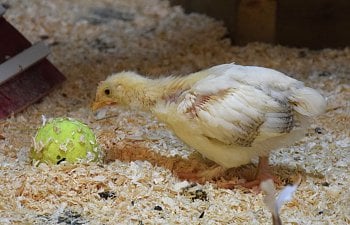
Greens and other edibles (no, not that kind) is a hit with both young and old. Remember they're meant as enrichment and not nutrition. Young birds should get limited treats, some prefer to not give them any the first month(s). If you do, do it for the entertainment value and give them something that will keep them occupied for a long time without spoiling their appetite.
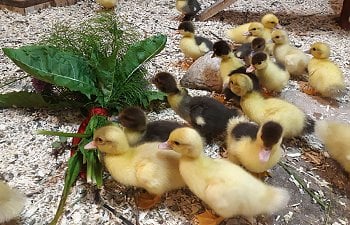
The bigger the chicks, the more they like to roost and climb, but they prefer to stay half a meter off the ground max. The smallest ones prefer using the heating plate as a resting place. The necessity of a physically complex environment is repeated in many of the studies as a way to reach the chicken's full cognitive potential. This comes with practice. For each wall, hinder, roost and ladder the chick tackles, it has to use its brain and learn. In my opinion this is where most brooders can improve, by adding items not only on the ground, but in height to literally create another level of difficulty.
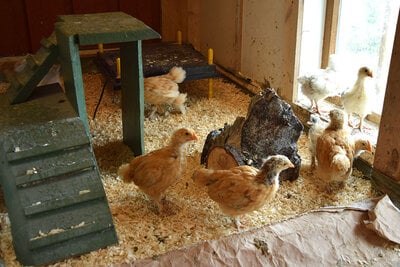
I got tons of spruce trees around and use brances to create hiding places. They love the privacy.
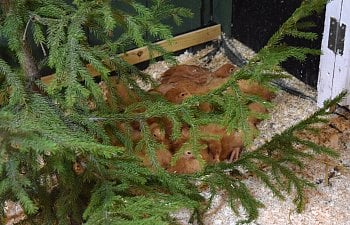
All in all, furnishing brooders and adding enrichment makes for happy and smart chicks. And it's fun for the owner too, go out and build a playhouse (preferably a better one than mine) and find some old balls and toys (clean them first...). Let the creativity flow into the brooder!
Resources
A review of environmental enrichment for laying hens during rearing in relation to their behavioral and physiological development
Influences of Maternal Care on Chicken Welfare
Sophisticated Fowl: The Complex Behaviour and Cognitive Skills of Chickens and Red Junglefowl
Selection method and early-life history affect behavioural development, feather pecking and cannibalism in layer hens (abstract only)
Early experience affects adult personality in the red junglefowl: A role for cognitive stimulation? (Abstract only)
